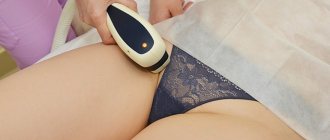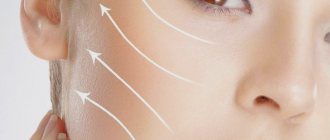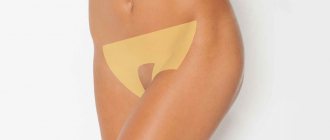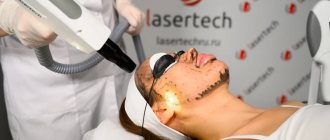Expert: Pavel Krayushkin
The annual reports of the American Society of Plastic Surgeons (ASPS) publish ratings of the most popular services in aesthetic medicine. For many years in a row, these ratings have been topped by injections of botulinum toxin and fillers, and only one hardware technique is always included in the top 5 most frequently performed procedures, according to ASPS - laser hair removal. In 2022, according to ASPS, 1,077,490 laser hair removal procedures were performed in the United States. Moreover, the number of such procedures is almost twice the total number of all other laser procedures in aesthetics combined.
The reason for the high demand is due to several factors: the global fashion for smooth, hair-free skin, shaped by years of efforts by companies selling shaving accessories and hair removal kits; pronounced advantages of laser hair removal compared to shaving and depilation; efforts of laser equipment manufacturers and clinics aimed at promoting this type of service.
The main advantages of laser hair removal for clients: the rapid achievement of the effect of stopping hair growth with a result that lasts six months or more, and the relative comfort of the procedures themselves. And from a business point of view, laser hair removal is an extremely attractive technique, since it is suitable for almost any patient (has a minimum of contraindications), easy to perform, simple to implement and highly profitable. This is confirmed by the existence of salons, clinics and networks that position themselves as specialized laser hair removal centers.
However, laser hair removal is only a seemingly simple technique. The success of procedures for removing unwanted hair depends on the equipment used, the parameters of its use, the technique of performing the procedures, the individual characteristics of the patient and his compliance with the doctor’s recommendations. In addition, thanks to the efforts of some marketers, many concepts that explain the features of laser hair removal are greatly simplified and distorted, which prevents buyers from understanding the variety of offers, and there are many of them. Over the past 20 years, dozens of manufacturers and hundreds of different models of laser hair removal devices have appeared on the market in the price range from several hundred thousand rubles to several million. There are mainly three types of lasers produced: alexandrite (755 nm), diode (800–810 nm) and long-pulse neodymium (Nd:YAG) (1064 nm).
Use of lasers for hair removal in Russia
All lasers for hair removal belong to medical devices, this is clearly interpreted by Part 1 of Article 38 of the Federal Law of November 21, 2011 No. 323-FZ. Therefore, before purchasing a device, you must make sure that it has a valid registration certificate from Roszdravnadzor. You can check this on the website www.roszdravnadzor.ru. Laser hair removal is included in the list of cosmetology works and services related to medical activities (approved by the Federal Service for Surveillance in Healthcare and Social Development of the Russian Federation). Finally, the laser hair removal procedure itself is carried out in a specially equipped room - a hardware cosmetology room.
The law clearly defines hair removal lasers as medical devices and laser hair removal as a medical service. This means that laser hair removal can only be performed in a beauty industry enterprise that has a medical license, and the laser hair removal device must have a registration certificate from Roszdravnadzor.
Some unscrupulous sellers mislead buyers by offering laser devices registered as household devices and promising the ability to operate them without a medical license. Buyers of laser hair removal devices without a registration certificate and specialists working with laser devices in institutions without a medical license are breaking the law. The penalties for this violation can be very serious, including criminal liability.
No. 8 – Candela GentleLase Pro-U
Alexandrite laser Candela GentleLase Pro-U is the “gold standard” in the beauty industry.
Candela GentleLase Pro-U
Advantages of the Candela GentleLase Pro-U laser:
- optimal wavelength: 755 nm;
- gentle removal of any type of hair;
- large diameter of the light spot and the ability to regulate its size;
- high frequency of pulse generation and the ability to adjust the duration of exposure;
- possibility of selecting temperature and type of cooling: air or cryogen;
- noticeable results after the first session;
- lack of rehabilitation period.
ATTENTION!
The disadvantage of alexandrite lasers is their very high cost, starting from several million rubles.
Choosing a laser for hair removal: a clinical view
The principle of laser hair removal is the destruction of the hair follicle during the process of heating it, which, in turn, occurs when laser radiation is absorbed by the hair shaft containing melanin. In simple terms, melanin heats the hair shaft, and the hair shaft heats the surrounding hair follicle cells, causing them to die. If the death of the stem cells of the hair follicle has been achieved, then the hair from this follicle will no longer be able to grow and the effect of permanent hair removal will be achieved.
Heating the hair shaft must take quite a long time so that the heat has time to spread around and reach the hair cells of the follicle, therefore long-pulse lasers are used for laser hair removal (with a pulse duration of tens and even hundreds of milliseconds).
Heating of the hair shaft occurs due to the absorption of radiation by melanin, therefore, in cases where there is little melanin in the hair shaft (blond hair), laser hair removal is ineffective. On the other hand, melanin is present in the upper part of the skin - the epidermis, so when using lasers on dark and dark skin, the question of protecting the epidermis arises.
If we summarize all the important points that affect the effectiveness, safety and comfort of laser hair removal, we can reduce them to several characteristics, a competent assessment of which will help you choose the desired laser. There are five such characteristics in total:
- wavelength of laser radiation;
- energy flux density (fluence);
- pulse duration;
- spot size;
- protection of the epidermis.
ET handle of the LightSheer DUET during laser hair removal of the chin area. Equipped with a contact cooling system (sapphire crystal)
Operating principle
Laser hair removal is famous for combining the incongruous – painlessness and effectiveness. How does this happen? The laser beam acts directly on the so-called “targets” - chromophores. The latter can be hemoglobin (for laser removal of vascular defects) or the pigment melanin contained in hairs (for removal of vegetation). Under the influence of a beam with a length of 700-810 nanometers, melanin is heated and cells are damaged, while surrounding tissue remains unharmed.
A – hair before exposure to laser radiation. B – solid-state alexandrite laser 755 nm: hair follicles of thin and thick hair are destroyed: there is an area of perifollicular damage.
The hairs burn immediately, and the damaged hair follicle falls out within a couple of weeks. As a result, hair growth stops. Sometimes the follicles recover over time, but this is a long process, taking several years. In this case, the course can be repeated. The darker the hair, the more melanin it contains, and the more effective the effect. If melanin is contained in large quantities in the skin (for example, after sunbathing), then burns are possible, so you should never sunbathe before the procedure.
However, technologies have now emerged that allow us to circumvent this ban, but we will talk about them at the end of the article.
Chromophores can be not only natural, but also artificial. For example, tattoos also absorb radiation and may fade as a result of treatment, so they are sealed or painted over with special pencils before the procedure.
An important nuance: the laser destroys only hairs in the growth phase. Therefore, no matter how effective the treatment is, several sessions will be required to achieve complete smoothness of the skin (the exact number will be determined by the doctor). But when all the follicles are destroyed, you can forget about the problem of unnecessary hair on the face and body for at least several years.
Wavelength: alexandrite, diode or neodymium?
As already mentioned, alexandrite, diode and Nd:YAG lasers are used for laser hair removal. Almost every manufacturer today claims that the type of laser used in its hair removal device is the “gold standard.” However, when choosing a laser, you should trust the data from clinical studies, of which quite a lot have accumulated to date. These data indicate the following: the radiation of the alexandrite laser (755 nm), as well as the diode laser operating at the same wavelength, is very well absorbed by melanin, therefore alexandrite hair removal is effective, but its effect is predominantly expressed in hair removal in patients with I–III phototypes, that is, on light skin. When removing hair from patients with IV–VI phototypes (on dark skin), these lasers are practically not used, since the melanin located in the epidermis is very hot and this can lead to the development of complications such as burns and hyperpigmentation. In addition, the penetration depth of the alexandrite laser is less than that of the diode (800–810 nm) and Nd:YAG lasers.
Absorption spectra of the main skin chromophores: melanin, hemoglobin and water. As the wavelength increases, the ability of melanin to absorb laser energy decreases, while at the same time the ability of laser radiation to heat the hair shaft increases and the ability of radiation to penetrate deep into the skin, to the location of the follicle, decreases.
A neodymium Nd:YAG laser produces radiation with a wavelength of 1064 nm. A diode laser works in a similar way with the same wavelength at which melanin is absorbed relatively poorly, but at the same time the penetration depth is maximum. Historically, Nd:YAG lasers entered the laser hair removal market due to their ability to perform procedures on patients with very dark and black skin (V–VI phototypes); such lasers have significant distribution in countries where the majority of the population is African American.
Diode lasers with a wavelength of 800–810 nm are the most versatile. And although their radiation is absorbed by melanin a little worse than the radiation of alexandrite lasers, they are widely used due to the fact that they can be effectively used on skin of any phototype.
Diode lasers (or laser diodes) for hair removal are a common name for semiconductor lasers in which the emitters are diodes based on aluminum gallium arsenide. They emit light in the range of 800–810 nm, but different manufacturers, varying from each other, may indicate a wavelength of 800, 805, 808 or 810 nm. The great technical advantage of diode lasers is their high efficiency, which makes it possible to assemble small-sized devices that do not require the use of bulky power supplies.
Indications for use
Neodymium laser is often used to remove scars, tattoos and various vascular diseases, and coagulate blood vessels. We have just mentioned this, but what we would like to dwell on in more detail is the issue of hair removal using such equipment.
Thus, a neodymium laser is recommended for use in cases of unwanted hair appearing on any part of the body or face, their ingrowth, as well as the appearance of severe skin irritations or blackheads after standard shaving. In addition, the resulting effect will last much longer than after other methods of removing unwanted hair on the body.
Fluency and spot size
Fluence (energy flux density) is the most important parameter on which the effectiveness of laser hair removal depends. This parameter means how much laser energy is transmitted per unit of skin surface during the procedure. The larger it is, the more energy will be delivered to the hair follicle. The fluence is directly related to the energy and power of the laser device, but is not an analogue of these parameters, but depends on the area of the spot. With a radiation energy of 100 joules (J), the distribution of this energy over a spot measuring 1x1 cm will give a fluence of 100 J/cm2. The same energy, 100 J, distributed over a spot measuring 2x2 cm, will give a fluence of 25 J/cm2.
When choosing a laser device, you should be interested not in its energy, but in its fluence, as well as the range in which this fluence can be changed. An hair removal laser with a low maximum fluence may be ineffective in some cases, for example for removing coarse (large diameter) hair.
The size of the spot is also an important parameter. Firstly, as the spot size increases, the proportion of scattered light decreases and, as a result, the penetration depth increases, and hence the efficiency in epilating deep-lying hair. Secondly, the large spot size allows large areas to be treated at high speed. For example, with a spot size of 2.2x3.5 cm, epilation of a man's back will take about 10 minutes, and with a spot size of 1x1 cm - more than an hour. However, despite the fact that the small size of the spot requires the use of a larger fluence, it cannot be completely abandoned, since it is needed for hair removal in hard-to-reach areas, for example, above the upper lip.
Diagram of the action of contact cooling during laser hair removal. The glass of the laser light guide is continuously cooled, so at the moment the laser pulse is applied, when the tip contacts the skin, the epidermis is cooled and protected from burns. An additional advantage of contact cooling is that the light guide presses the skin, the hair shafts take a horizontal position and move closer to the light guide.
No. 16 - Fotona
The Fotona laser is produced in Slovenia and is successfully used by a number of well-known cosmetic clinics, as well as for the treatment of some surgical pathologies.
Fotona
The effect of this device is focused exclusively on the hair follicle and allows you to avoid burns and bypass the rehabilitation period. The area of radiation exposure is quite large, which makes it possible to increase work efficiency and reduce procedure time.
Attention!
The effect of the procedure does not appear immediately. It is necessary to undergo 2 to 3 laser hair removal sessions. The effect lasts from 2 to 3 years.
Pulse duration and series of sub-pulses
It takes some time for the heat to spread from the heated hair shaft to the stem cells of the follicle. This means that short-pulse lasers are not suitable for laser hair removal; or rather, the use of such lasers will burn out the hair shaft, but may leave the follicle stem cells undestroyed. Typically, laser hair removal uses pulses lasting from 10 to 100 milliseconds or more. Moreover, short pulses are suitable for thin hair, and long pulses are suitable for thick, coarse hair.
Influence of spot size on the penetration depth of laser radiation. As radiation penetrates the skin, it is scattered, so as the size of the spot increases, the depth at which the effective fluence value will be achieved will increase.
A good property of a laser for hair removal is the ability to emit a series of sub-pulses with short intervals between them. This method allows you to gradually warm up the hair shaft without the risk of damaging the epidermis: in the intervals between pulses, the epidermis has time to cool down, but the hair does not.
No. 15 - Motus AX Moveo
Motus AX is an Italian laser with Moveo technology. The unique structure of the device allows it to be used to remove hair and age spots.
Motus AX Moveo
The time of one session depends on the skin phototype: hairs are removed faster and more efficiently from light skin. The nozzle emits a luminous flux with a diameter of up to 1 cm; the desired effect can be achieved in 25 seconds. During the session, even small light hairs are removed; no rehabilitation period is required.
Epidermal protection
During any laser hair removal, laser radiation first encounters the epidermis, which always contains a lot of melanin: it is present even in light skin of people with phototype I. This circumstance requires the use of various methods of removing heat from the surface of the skin, in other words, cooling it.
There are three common ways to cool the skin: using cryogas, a stream of cold air and contact. A combination of these methods is also used. In the first case, an inert non-flammable substance, for example tetrafluoroethane, is supplied to the skin in the direction of the laser pulse, which quickly evaporates and cools its surface as it evaporates. Cooling using cryogas is also called dynamic cooling. In the second case, the skin is blown with a continuous flow of cold air. For this, as a rule, additional equipment is used - cold air generators, for example Cryo devices (Zimmer MedizineSysteme, Germany). The third method is to use sapphire light guides, which are in contact with the skin and are forcibly cooled using Peltier elements.
All three methods allow you to effectively cool the skin, however, the contact method may be more preferable, since when using it, the cooling efficiency is less dependent on the procedure technique: the glass of the light guide is always in contact with the skin during the pulse. The contact cooling method is typical for diode lasers, as well as for IPL systems.
An ideal laser for hair removal should have high fluence, the ability to generate both long and short pulses, operate in sub-pulse mode, be equipped with light guides with different spot sizes for different tasks, including large spot sizes for quickly treating large areas, and reliable system for removing heat from the surface of the skin.
No. 13 - Viastar 810
Viastar 810
The Viastar 810 laser is a domestic device with an impressive set of characteristics:
- generation of up to 20 million pulses,
- wavelength – 810 nm,
- device power – 600 W,
- continuous operation 12 hours,
- suitable for any skin type,
- the movable emitter handle allows you to remove hair in hard-to-reach places,
- Russian-language menu.
To completely get rid of unwanted vegetation, 3-4 procedures will be required, the interval between sessions is 4-5 weeks. The interval between sessions is necessary for complete regrowth of existing hair and complete destruction of follicles.
Choosing a laser for hair removal: a patient's view
Patients value efficiency, safety, convenience and comfort. The effectiveness of laser hair removal is determined by the correct choice of procedure parameters, primarily fluence and pulse duration. As already mentioned, high fluence provides high efficiency, but the downside of using high fluence is discomfort during the procedure. Some of the discomfort can be reduced by using contact cooling. Some laser systems use “in motion” treatment of the skin to increase comfort.
One of the effective ways to reduce discomfort during laser hair removal is the use of vacuum enhancement: a technology in which, during the pulse, the irradiated area of the skin surface is drawn by vacuum into the cavity of a special handle. In this case, the effect of vacuum distracts the patient from discomfort and high effective fluence values can be used almost painlessly.
The convenience of laser hair removal consists of many nuances: is it necessary to prepare for the procedure (shaving the hair the day before the procedure), is it necessary to use contact gel before treatment and remove it after completion, is it necessary to apply markings to the skin and, finally, how long does the procedure take? and stages of preparation for it. When purchasing a laser for hair removal, you should find out all these nuances; to do this, you can interview real people who have undergone the procedure on this device. It also makes sense to test the procedure yourself.
No. 14 - In Motion D1
The In Motion D1 laser has a number of advantages over its competitors:
In Motion D1
- Pulse generation speed up to 20 million.
- The Intellectual Cooling System protects the device from overheating and damage, and also controls the temperature impact on the skin.
- Equally effectively removes dark hair with a hard shaft and fine light hairs and ingrown hairs.
- Suitable for visitors with low pain tolerance and allergy sufferers.
- Noticeable effect after the first procedure: hair thinning and depigmentation.
The kit includes an emitter with a pulse generation reserve of 20 million and a power of 500 W. The touch monitor allows you to precisely adjust the radiation parameters and select the optimal operating mode for each visitor.
Attention!
Now this device has received a Registration Certificate.
Choosing a laser for hair removal: a businessman's view
Laser hair removal is a popular and highly profitable procedure. However, its profitability is directly related not only to quality marketing, but also to the choice of hair removal device. What issues should concern business owners, investors and managers?
- Number of procedures per day.
This parameter is associated with the popularity of a particular laser hair removal procedure in your location, which, in turn, is associated with its clinical benefits and promotion. Don’t forget about the speed of procedures; this is often the most important factor. The higher the speed of procedures and the less time the preparation stage takes, the more services can be performed in a day.
HS handle of the LightSheer DUET device during the laser hair removal procedure of the legs. Equipped with a vacuum amplification system and has a spot size of 22x35 mm
- Consumables.
Most lasers do not have direct consumables, but there are always components that require periodic replacement. As a rule, replacement requires serious investments: from several tens of thousands of rubles to a million or more. For example, in alexandrite lasers, the active medium pump lamps, the active medium itself (Alexandrite) and the optical fiber that conducts radiation from the laser unit to the skin must be regularly replaced. In diode lasers, the handle is usually replaced, which itself is an emitter; diodes are built into it.
Emitters are designed to last a certain number of flashes, and manufacturers may advertise that their lasers are designed to last 10 or even 100 million flashes. However, when choosing a laser, it is fundamentally important to know not the resource of the emitter, which is predictive, but the actual conditions of the warranty and its maintenance. Additionally, the number of outbreaks does not reflect the number of procedures performed. For example, when using "in motion" lasers, the procedure technique is such that the total number of flashes can be many times greater than with a conventional sequential processing technique. Large spot size lasers will require far fewer flashes to treat a patient than small spot size lasers.
In any case, when choosing a laser for hair removal, you should read the warranty agreement in detail and calculate the possible costs of repairs and replacement of parts that have expired.
- Downtime.
Any laser devices break down sooner or later. The businessman’s task is to assess the risks that follow when the device breaks down. The better the engineering service of the manufacturing company (distributor), the faster the laser will be repaired in the event of a breakdown, which means the less money the clinic or salon will lose during its repair and the less downtime will affect its reputation in the eyes of clients.
- Trained staff.
Contrary to popular belief, laser hair removal is not a simple procedure. A number of studies conducted abroad in the last decade have shown that the quality of laser hair removal procedures, primarily the frequency of complications, strongly depends on the qualifications of the personnel. In most cases, manufacturers create the ability to work on preset parameters, but these parameters, as a rule, give a very average result, since they are designed for the “average patient” and are underestimated to ensure guaranteed safety. The task of a laser hair removal specialist is to select the optimal parameters in each specific case, and for this, such a specialist must undergo thorough training in working with a specific device.
At Premium Aesthetics you can purchase the following types of cosmetology equipment:
|
|
No. 11 – Soprano XL Ice
The hybrid laser epilator Soprano XL Ice is produced in Israel by Alma Lasers.
Soprano XL Ice
The main advantage of this laser is its advanced cooling system, which regulates the rate of heating of the skin, preventing burns. The radiation from the sapphire tip not only removes hair, but also helps rejuvenate the skin and increase tone.
The special structure of the handle allows you to remove even hard-to-reach hairs.
IMPORTANT!
Before the procedure, 2-3 days before, you need to shave your hair. Hair will begin to fall out 7 days after the procedure; re-growth is excluded. After hair removal, sunbathing and using cosmetics are strictly contraindicated.











